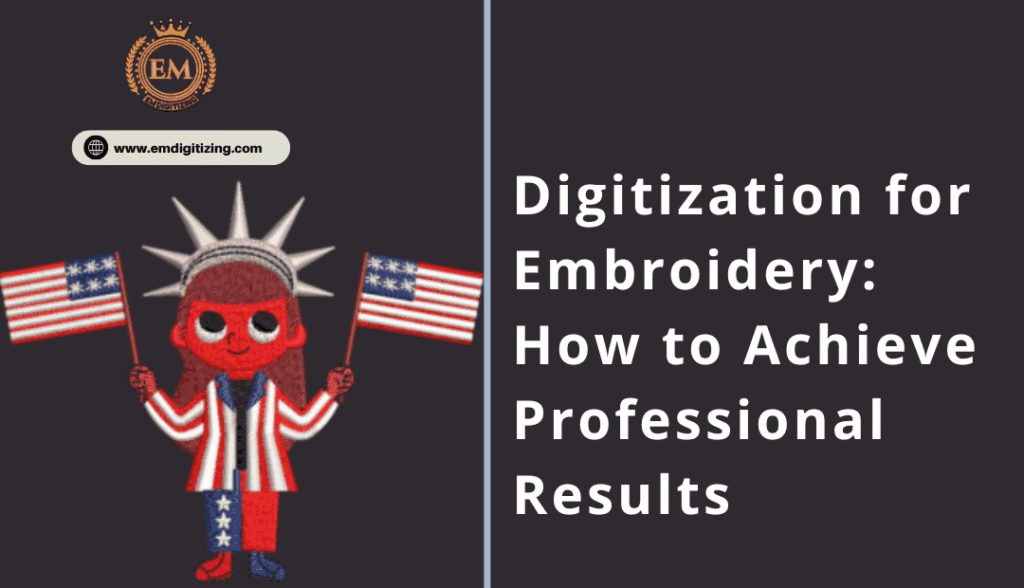In the world of modern fashion, branding, and personalization, embroidery continues to be one of the most timeless and stylish methods of decorating fabric. From elegant monograms to bold logos on uniforms, embroidery provides durability and a sophisticated finish that printing often cannot match. However, achieving professional results in embroidery doesn’t just depend on the machine or the fabric—it begins with digitization for embroidery.
Digitization is the process of converting artwork, logos, or designs into a digital file that embroidery machines can read and stitch with accuracy. Without proper digitization, even the most beautiful artwork can result in distorted or uneven embroidery. This makes digitization the backbone of modern embroidery services. In this blog, we’ll explore how digitization works, why it’s crucial, and how you can ensure professional-quality results every time.
What Is Digitization for Embroidery?
Digitization for embroidery involves translating a design into a stitch file that embroidery machines understand. Unlike simple graphic files such as JPEG or PNG, embroidery machines require a file that contains stitch paths, density, sequence, and direction. These details determine how the final embroidery looks on fabric.
A digitizer uses specialized software to break down an image into stitches, ensuring it translates correctly onto fabric. This step involves creativity, technical precision, and a strong understanding of stitch types.
Why Digitization Is Essential for Professional Results
Without quality digitization, embroidery can suffer from issues like thread breaks, uneven stitching, or poor alignment. Here’s why proper digitization makes a difference:
1. Accuracy and Precision
Digitization ensures that each stitch is placed exactly where it needs to be. This accuracy is what makes a logo or design appear crisp and clear.
2. Adaptability for Fabric Types
Different fabrics require different stitch densities and underlay. For example, embroidery on cotton differs greatly from embroidery on stretchy polyester. Digitization adjusts for these variations.
3. Consistency in Bulk Orders
When you need 100 or even 1,000 embroidered shirts, digitization ensures that every piece looks identical.
4. Design Versatility
Whether it’s a simple name on a cap or a detailed company logo on a jacket, digitization makes it possible to scale designs while maintaining quality.
Key Steps to Achieve Professional Results with Digitization for Embroidery
1. Start with High-Quality Artwork
Digitization begins with the original design. Low-resolution or blurry images make it harder to digitize accurately. Always provide your digitizer with clear, high-resolution files.
2. Choose the Right Software and Tools
Professional digitizers use advanced software like Wilcom, Hatch, or Pulse. These tools allow precise control over stitch direction, density, and underlay, which are crucial for flawless embroidery.
3. Understand Stitch Types
Different stitch types create different visual effects. For instance:
-
Satin Stitch: Ideal for borders, text, and small details.
-
Fill Stitch: Used for larger areas of color.
-
Running Stitch: Great for fine outlines or detailing.
A skilled digitizer knows when and how to use each stitch type for the best outcome.
4. Adjust for Fabric and Garment Type
Not all fabrics react the same way to embroidery. For example, fleece requires more underlay to prevent the design from sinking into the material, while silk requires lighter stitches to avoid puckering. Proper digitization takes these differences into account.
5. Pay Attention to Stitch Density
Too many stitches can make the fabric stiff, while too few can leave gaps. A balanced density ensures smooth, even embroidery.
6. Proper Thread Pathing and Sequence
The order in which the machine stitches the design matters. A professional digitizer arranges the sequence logically to minimize thread breaks and ensure clean results.
7. Run Test Stitches
Before going into bulk production, running a test stitch ensures the design translates perfectly onto the actual fabric. Adjustments can be made to improve quality.
Common Mistakes in Embroidery Digitization (and How to Avoid Them)
-
Using Low-Resolution Artwork
Solution: Always provide vector files or high-resolution images. -
Ignoring Fabric Type
Solution: Customize digitization settings based on the garment. -
Overlooking Small Details
Solution: Simplify overly complex designs so they translate better in stitches. -
Incorrect Stitch Density
Solution: Balance stitch counts to prevent fabric puckering or stiffness. -
Skipping Test Runs
Solution: Always test your design before mass production.
Benefits of Professional Digitization for Embroidery
1. Crisp, Clear Designs
Logos, monograms, and artwork retain their integrity and look polished.
2. Time and Cost Efficiency
Proper digitization reduces errors, saving time and materials during production.
3. Scalability
Designs can be resized without losing detail or accuracy.
4. Enhanced Brand Image
For businesses, professional embroidery with clean digitization boosts brand credibility and professionalism.
5. Durability
High-quality digitized designs withstand repeated washing without losing shape.
Digitization for Embroidery: Best Practices for Businesses
If you’re a business owner looking to add embroidery to your branding, here’s how to ensure professional results:
-
Work with Expert Digitizers: Don’t rely on automated tools—human expertise matters.
-
Simplify Your Logos: Clean, simple designs often embroider better than highly detailed graphics.
-
Ask for Samples: Before committing to bulk orders, request test embroidery samples.
-
Consider Placement: Whether on caps, shirts, or jackets, digitization should be adjusted for the garment’s shape and surface.
-
Invest in Quality Threads and Fabrics: Even the best digitization can’t compensate for poor materials.
The Future of Digitization for Embroidery
Technology is making digitization smarter and faster. Artificial intelligence (AI) is beginning to play a role, enabling automated adjustments for stitch density and pathing. Cloud-based collaboration also makes it easier for businesses to work with digitizers worldwide. As fashion and branding demand more personalization, digitization will remain at the heart of embroidery.
Conclusion
Digitization for embroidery is not just a technical step it’s the foundation of achieving professional, high-quality results. From ensuring precise stitching to adapting designs for different fabrics, digitization bridges the gap between artwork and reality. Whether you’re a business looking to create professional uniforms or an individual personalizing gifts, investing in professional digitization guarantees embroidery that is crisp, durable, and visually striking.
If you want to elevate your embroidery projects, remember: great results always begin with great digitization.
FAQs
Q1. What is digitization for embroidery?
It is the process of converting artwork or logos into a stitch file that embroidery machines can read and sew.
Q2. Can I digitize my own designs?
Yes, with embroidery software and practice, but professional digitizers typically achieve more precise results.
Q3. Why do fabrics affect digitization settings?
Different fabrics stretch, absorb, or resist stitches differently, requiring unique adjustments for stitch density and underlay.
Q4. How much does embroidery digitization cost?
Costs vary depending on design complexity, but most services are affordable and save money in the long run by reducing errors.
Q5. Is digitization a one-time process?
Yes, once a design is digitized, it can be reused on different garments, though adjustments may be needed for fabric types.



